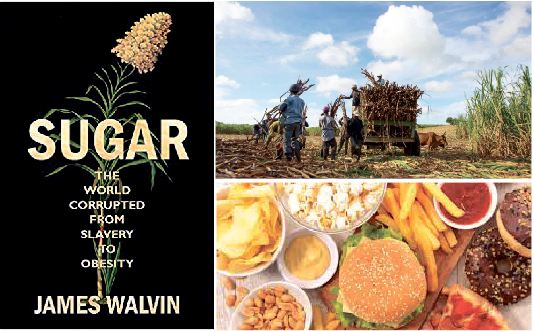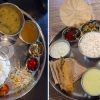Goa is abuzz with excitement as vintage bike and car owners, users, collectors and fans are decking […]

SUGAR, SUGAR, SUGAR!
Life & Living, Mar 07- Mar 13 2020 March 6, 2020Oh, we are so hung up on sugar! Read the billion dollar sleaze story of how one of our first industrial ingredients became a household favorite …and you’ll never want to even look at sparkling white sugar ever again! Sugar is a chemical and is everywhere in our food industry be it biscuits, confectionary, soda drinks, sherbat, take-away foods, etc. Cheap carbohydrate killers all!
By Tara Narayan
SPARKLING refined white sugar is everywhere and we get so excited about it, in love with sugar and sugary drinks and foods forever unto death! I’ve read enough and personally experienced enough to make me throw out sugar from my kitchen some years ago…although I will occasionally, very occasionally, seek out a rossogolla or mava gulab jamun or even get jelebi for an occasion…but for every day drinking and cooking I’ve turned in favor of organic wholesome, mineral rich jaggery cubes or powder…for sweetening my morning tea, or adding a bit to dal, kadi, sabzi or salad dressing. I do not use sugar in my home cooking at all.
Said goodbye to refined white sugar long ago; and even then I can tell you on days when I indulge in chocolate or some selected sweet I find after ages and want to relish for old times sake (Gujarati marriage safed magaz or creamy white jalebi or my mother’s gorpapdi!) eating sweet plays havoc with my endocrine system, if I eat sweet in the evening, I find myself getting up two or three times at night to visit the bathroom. So evening times I no longer indulge in sweet anything and for days on end I’m off sugar in anything and promise you I stay better those days! And if I go for a walk, all the better. But then I’m neither diabetic nor border-line diabetic or insulin resistant yet…insulin resistant maybe though on occasion.
It’s really a carbohydrate problem and usage of sugar is number one on the list of carbohydrate eating. It’s been said that we Indians eat too many refined carbohydrates in our constantly fried, sugary, refined diets, plus we also like our salties – hence the high incidence of diabetes, heart disease, arthritis, cancer, the gradual loss of energy as free radicals and inflammation have a field day with our aging cellular system. Plus, we’re so much in love with our mod con lifestyles that we hate to even walk…okay, I’m speaking for myself.
The sugar story is well known but recently I found a book Sugar, The World Corrupted from Slavery to Obesity’ by James Walvin and was utterly wrapped up in it, the history of how sugar has become such a mega killer industry in our lives. How did a simple commodity, once the most prized monopoly of kings and princes, become such an essential ingredient in our lives rich and poor and engineer such a global epidemic of obesity? Our sugar barons make up the 2% fabulous rich in the country and indeed, globally. At first the rich thought, wow, beautiful white sugar, the poor couldn’t afford it; then rich grew wise and now they shun sugar while the poor are addicted to it…rich man’s indulgence has become poor man’s indulgence, quick pick me up in so much junk food and scores of bottled and tetrapack drinks…some folk take pride in not drinking good old water but they spend their lives chasing bottled drinks of the intoxicating and non-intoxicating kind. TheSugar’ book traces the history of industrial sugar and its relationship with our contemporary dietary concerns because sugar is so pernicious, it is everywhere in our industrial food chain…sugar has come a long, long way from the times when the first slave gangs in 16th century Brazil , through indentured Indian laborers in Fiji, the Japanese in Hawaii or the South Sea islanders worked on sugar plantations to make sugar into a multibillion business across the world.
Cuba became the America’s “Sugar Kingdom” and America invaded Cuba in the war of 1898…all this and much more about an ingredient we now consider in health conscious circles as enemy number one! In India it’s in recent times that we’ve woken up to the dangers of consuming sugar in all our food cooked at home or in industrial foods bottled soda drinks, we’re also more educated about the extensive ecological harm sugar plantation do to the land. It is refined carbohydrate enemy number one in our diets along of course with other enemies like refined oils, hydrogenated vegetarian fats with such evocative brands names, also refined white flours like maida…excessive salt consumption.
Cut down drastically on guzzling sugar, fat, salt, maida-laden industrial goodies – if you can – and see the dramatic difference for the better you will do with the host of degeneration diseases plaguing you and for which are undoubtedly popping several medications prescribed by our doctor. It must be on the basis of all things being equal though.
Hey, be an ardent fruitarian but remember fruit too is a simple, natural carbohydrate….doing great within limit, ditto for other natural sweeteners like much loved honey, jaggery, syrups derived from palm juices, maple syrup, etc.
All carbohydrates impact the endocrine system, what makes you fat, fatter, obese, diabetic, yes, even cancerous. The medical research is all there, google and find out. The introduction of sugar in our diets has changed our very palate…despite the health scares every now and again sugar consumption remains higher than ever before in some countries where sugar is consumed as high as 50 kg per person per year. Never mind that those who’ve wised up shun sugar like the plague or give it pariah status atleast!
The history of sugar from the 15th century to the 21st century is worth reading up, although today sugar addiction is denounced as a dangerous addiction. Most educated lot know it, yet like me we fall into temptation, albeit very, very occasionally if we’re conscious of sugar’s contribution to fighting fit health parameters or dying slowly with our feet turning crusty and black with runaway diabetes…surely you have seen bedridden old-timers begging for churma ladoo, jelebi or shrikhand everyday with their thepla and rotli! I know of caretakers of senior citizens who deny sweet somethings to their patients while the rest of the family is hogging on them – yes, they get tightly slapped! Such is the craving for something sweet which hastens our departure from the good earth….
It’s a fascinating sugar story of how its social importance grew in colonial America after sugar-loaded foods became well-entrenched in Europe…then came the ice-creams, candies, biscuits, cakes, pastries, puddings, I need not go into the entire repertoire of where all industrial white sugar travells to blind us royally with its treacherous tastes and flavors. Sugar played a role in political relationships, trading in it was banned during the colonial times…but there was always smuggling. An interesting tidbit to learn is that the “French and English courts suffered dreadfully from dental problems – rotten and missing teeth, gum disease, collapsed mouths and disfigured appearances. All were a consequence of sugar.”
In comparison after the eruption of Mount Vesuvius on 24 August AD 79 when Pompeii and Herculaneum were destroyed and later on when they were excavated and teams of scientists, archaeologists, radiologists, doctors and dentists analysed human remains, what do you know! “The remains of thirty people, examined by modern Ct scans, have revealed, among other things, remarkably good dental condition. Scans, X-rays and dental analysis suggest that the victims (men, women and children) had no real need of dental treatments: few of them had cavities. When they died, their teeth were in very good condition.” Any wonder today so many dieticians tell us to adopt a fibre-rich Mediterranean diet, characterized by lots of fruit and vegetables…that’s a balanced diet!
To go on, in middle-class communities in Delhi, according to a WHO report of 2005, “32 per cent of men, and 53 percent of women, were thought to be obese. Indeed, one Indian in five is considered overweight. Not unrelated, an estimated 75 per cent of foreign investment in India has been in highly processed foods….” There is the China story of being “exposed to Western foods and now 350 million people who are overweight, and 60 billion regarded as obese.” Ironic, a lot of obesity is credited to malnutrition or malnourishment!
Former First Lady Michelle Obama was so concerned about childhood obesity that she knocked on the food industry’s doors fiercely to convince them to put in more fresh salads in the fast foods of America which not only poor obese black but white children feasted in cheap junk foods and drinks…carbohydrate foods in combo with fats come with dreadful and damaging high calorie index.
The healthcare industry has been making the linkages between refined carbohydrate consumption and obesity and diseased body beautiful…but barely so! My friend Dr Lenny D’Costa is writing a book to tell us “What your doctor is not telling you to keep you sick!” Catch his Facebook talks if you can. But to stay with sugar consumption and my reading up currently, `Sugar’ by James Walvin confirms anew that obesity leads to type 2 diabetes, hypertension, myocardial infarction, angina, osteoarthritis, stroke, gut and gall bladder disease, colonic and ovarian cancer…It is also thought that obesity places great mechanical stress on the body and may even lead to sleep problems, breathing difficulties and back trouble. This cluster of health issues for overweight people is known as ‘metabolic syndrome’.”
This is to say even in India it should be the aim of all health departments to reduce the volume of sugar, fats and salt currently saturating the mass-produced, processed foods and drinks of the food industry to contribute significantly to our growing national obesity. Needless to say, nobody gives a damn, nothing moves in an India woefully obsessed by religious shenanigans and political nitpicking but not the dismal status of our health and healthcare.
So my this week’s message: If you haven’t already done so, say goodbye to sugar and sugar-infested foods as much as you can for more than reasons of health – the rise of industrial sugar has an exploitative history courtesy slavery, not to mention the march of dental decay and most every health problem we suffer from today. Down with sugar!
CARROT CAKE LATTE

Excerpted from ‘Sugar, The World Corrupted From Slavery To Obesity’ by James Walvin….
THE taste for sweetness in food and drink is universal, and the cultivation of sugar is global. A great variety of sugar cane is cultivated in the tropics, while sugar beet is cultivated in temperate regions. But the engine behind the rise of sugar’s popularity was cane sugar. Its early history in Indonesia, India and Chin, was small-scale and aimed solely at local markets. But when sugar cane was transplanted to plantations in the Mediterranean, then into islands in the Atlantic, the story changed – and even more dramatically when sugar crossed the Atlantic to the Americas, there, sugar cane was cultivated and converted to sugar by enslaved Africans (themselves shipped across the Atlantic). It was this slave-grown sugar that brought about revolutionary changes in the landscapes of the sugar colonies while transforming the tastes of the Western world.
As Europeans and Americans settled and traded with the wider world in the course of the nineteenth century, they transplanted commercial sugar cultivation to new locations to islands in the Indian Ocean, to Africa, Indonesia, to Pacific islands and to Australia. But wherever sugar took hold, local sugar planters had problems with labour. They found the answer in imported, indentured labour. From one sugar region to another – from Brazil to Hawaii – the sugar plantation became the home of alien people – people who had been uprooted and shipped vast distances to undertake the grueling, intensive labour on sugar plantations.
For all that, sugar plantations more than proved their worth to their owners and investors. But there was a price to pay for the development of the sugar plantation. The natural environments were hugely damaged by the development of sugar. From Barbados in the 1640s to the Florida Everglades in recent years, the ecological harm caused by sugar plantation has been enormous, and is only now being fully recognized. It is, however, the human cost of sugar cultivation which is most obvious and dramatic. It is at its most visible in the labour force, from the first slave gangs in sixteenth century Brazil through to indentured Indian labourers in Fiji, the Japanese in Hawaii or the `South Sea Islanders’ shipped to Australia in the late nineteenth century. Cultivating sugar cane was a harsh business, and it was the labour of slaves and indentured labourers that transformed sugar from a luxury item to an essential commodity. Within the space of two centuries – roughly between 1700 and 1900 — – sugar became a dietary essential for all sorts of people the world over.”















